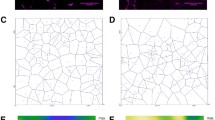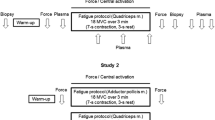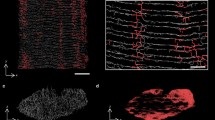Abstract
This paper explores the role of the calcium entry blocker nifedipine in the explanation of eccentric exercise-induced fibre damage by changes in skeletal muscle microcirculation. Eccentric exercise (EE) was induced by indirect stimulation of rat soleus muscle in its lengthening phase during cycling. Muscle damage was assessed by histology, electron microscopy and muscle tension 48 h later. Diameters of arterioles and venules, their response to dilator and constrictor stimuli and pattern of capillary flow were measured in epiiluminated muscles using intravital microscopy. Tetanic tension developed by EE muscles was lower (8.60 ± 1.02, means ± SEM, n = 8 N g−1 wet weight compared to 12.25 ± 0.56 in controls, P < 0.01). Electron microscopy showed changes similar to those in muscles exposed to EE by downhill running (Z line streaming, disruption of sarcolemma, swollen tubules). A total of 16% of muscle fibres were damaged, and fibre areas and interstitial space were enlarged. Capillary red blood cell flow showed tendency to a greater intermittency. Large venules were narrower, but arterioles and smaller venules had diameters similar to control muscles. Vessel dilatation to topically applied 10−4 M adenosine was attenuated. Daily administration of calcium entry blocker nifedipine by gavage (2 mg/kg/day in two equal doses) removed the narrowing of venules, restored the dilator response of all vessels to adenosine and increased capillary:fibre ratio. The percentage of damaged fibres decreased to 4.7 and the size of the interstitial space and fibre areas was normalized. Thus muscle damage caused by eccentric exercise was attenuated by nifedipine due to its beneficial effect on muscle microcirculation, which was impaired by eccentric exercise.






Similar content being viewed by others
References
Armstrong RB (1984) Mechanism of exercise induced delayed onset muscle soreness—a brief review. Med Sci Sports Exerc 16:529–538
Armstrong RB, Warren GL, Warren JA (1991) Mechanism of exercise-induced muscle fiber injury. Sports Med 12:184–207
Beaton LJ, Tarnopolsky MA, Phillips SM (2002) Contraction induced muscle damage in humans following calcium channel blocker administration. J Physiol 544:849–859
Dawson JM, Tyler KR, Hudlicka O (1987) A comparison of the microcirculation in rat fast glycolytic and slow oxidative muscles at rest and during contractions. Microvasc Res 33:167–182
Duarte JAR, Soares JMC, Appell HJ (1992) Nifedipine diminishes exercise-induced muscle damage in mouse. Int J Sports Med 13:274–277
Duarte JA, Carvalho F, Bastos ML, Soares JMC, Appell HJ (1994) Do invading leucocytes contribute to the decrease in glutathione concentrations indicating oxidative stress in exercised muscles, or are they important for its recovery. Eur J Appl Physiol 68:48–53
Egginton S (1987) Effect of an anabolic hormone on striated muscle growth and performance. Pflugers Arch 410:349–355
Faulkner JA, Jones DA, Round JM (1989) Injury to skeletal muscles of mice by forced lengthening during contractions. Q J Exp Physiol 74:661–670
Fleckenstein JL, Haller RG, Bertocci LA, Parkey RW, Peshock RM (1992) Glycogenolysis, not perfusion, is the critical mediator of exercise-induced muscle modifications on MR images. Radiology 183:25–27
Friden J, Lieber RL (2001) Eccentric exercise-induced injuries to contractile and cytoskeletal muscle fibre components. Acta Physiol Scand 171:321–326
Hellsten Y, Ahlborg G, Jensen-Urstad M, Sjodin B (1988) Indication of in vivo xanthine oxidase activity in human skeletal muscles during exercise. Acta Physiol Scand 134:159–160
Hellsten Y, Frandsen U, Orthenblad N, Sjodin B, Richter EA (1997) Xanthin oxidase in human muscle following eccentric exercise: a role in inflammation. J Physiol 498:239–248
Howell JN, Chleboun G, Conatser R (1993) Muscle stiffness, strength loss, swelling and soreness following exercise-induced injury in humans. J Physiol 464:183–196
Hudlicka O (1991) What makes blood vessels grow? J Physiol 444:1–24
Kano Y, Padilla DJ, Behnke BJ, Hageman KS, Musch TI, Poole DC (2005) Effects of eccentric exercise on microcirculation and microvascular oxygen pressures in rat spinotrapezius muscle. J Appl Physiol 99:1516–1522
Lieber RL, Friden J (1999) Mechanism of muscle injury after eccentric contraction. J Sci Med Sport 2:253–256
Lieber RL, Schmitz MC, Mishra DK, Friden J (1994) Contractile and cellular remodelling in rabbit skeletal muscle after cyclic eccentric contractions. J Appl Physiol 77:1926–1934
McCully KK (1986) Exercise induced injury to skeletal muscle. Fed Proc 45:2933–2936
McGillivray-Anderson KM, Faber JE (1990) Effect of acidosis on contraction of microvascular smooth muscle by alpha1 and alpha−2 adrenoceptors. Implication for neural and metabolic regulation. Circ Res 66:1643–1657
McNeil PL, Khakee R (1992) Disruption of muscle fibre plasma membranes - role in exercise-induced muscle damage. Am J Pathol 140:1097–1109
Mian R, Marshall JM (1991) The role of adenosine in dilator responses induced in arterioles and venules in skeletal muscle by systemic hypoxia. J Physiol 443:499–511
Michna H (1989) Ultrastructural features of skeletal muscle in mice after physical exercise: its relationship to the pathogenesis of leucocyte invasion. Acta Anat 134:276–282
Newham DJ, McPhail G, Mills KR, Edwards RHT (1983) Ultrastructural changes after concentric and eccentric contractions of human muscle. J Neurol Sci 61:109–122
Ogilvie RW, Armstrong RB, Baird KE, Bottoms CL (1988) Lesions in the rat soleus muscle following eccentrically biased exercise. J Anat 182:335–346
O’Reilly KP, Warhol MJ, Fielding RA, Frontera WR, Meredith CN, Evans WJ (1987) Eccentric exercise-induced muscle damage impairs muscle glycogen repletion. J Appl Physiol 63:252–256
Peeze-Binkhorst FM, Slaaf DW, Kuipers H, Tangelder GJ, Reneman R (1991) Exercise-induced swelling of rat soleus: its relationship with intramuscular pressure. J Appl Physiol 69:67–73
Proctor KG, Duling BR (1982) Adenosine and free flow functional hyperemia in striated muscle. Am J Physiol 242:H688–H697
Proske U, Morgan DL (2001) Muscle damage from eccentric exercise: mechanism, mechanical signs, adaptation and clinical applications. J Physiol 537:333–345
Rodenburg JB, Deboer RW, Schiereck P, Vanechteld CJA, Bar PR (1994) Changes in phosphorus compounds and water content in skeletal muscle due to eccentric exercise. Eur J Appl Physiol 68:205–213
Shafat A, Butler P, Jensen RL, Donnely AE (2004) Effect of dietary supplementation with vitamin C and E on muscle function during and after eccentric contractions in humans. Eur J Appl Physiol 93:196–202
Stauber WT, Clarkson PM, Fritz VK, Evans WJ (1990) Extracellular matrix disruption and pain after eccentric muscle action. J Appl Physiol 69:868–874
Waite RP, Pang CC, Walker MJ (1990) Effect of verapamil, nifedipine and flumarazine on haemodynamics and regional blood flow in pentobarbitone anaesthetised rats. J Pharm Pharmacol 42:3325–3331
Warren JAQ, Jenkins RR, Packer L, Witt EH, Armstrong RB (1992) Elevated vitamin E does not attenuate eccentric exercise-induced muscle injury. J Appl Physiol 72:2168–2175
Zebra E, Komorowski TE, Faulkner JA (1990) Free radical injury to skeletal muscles of young, adult and old mice. Am J Physiol 258:C429–C435
Ziada AMAR, Hudlicka O, Tyler KR, Wright AJA (1984) The effect of long-term vasodilatation on capillary growth and performance in rabbit heart and skeletal muscle. Cardiovasc Res 18:724–732
Author information
Authors and Affiliations
Corresponding author
Additional information
SJH and GLF share the first authorship.
Rights and permissions
About this article
Cite this article
Heap, S.J., Fulgenzi, G.L. & Hudlicka, O. Microcirculation in rat soleus muscle after eccentric exercise: the effect of nifedipine. Eur J Appl Physiol 97, 687–694 (2006). https://doi.org/10.1007/s00421-006-0239-0
Accepted:
Published:
Issue Date:
DOI: https://doi.org/10.1007/s00421-006-0239-0




